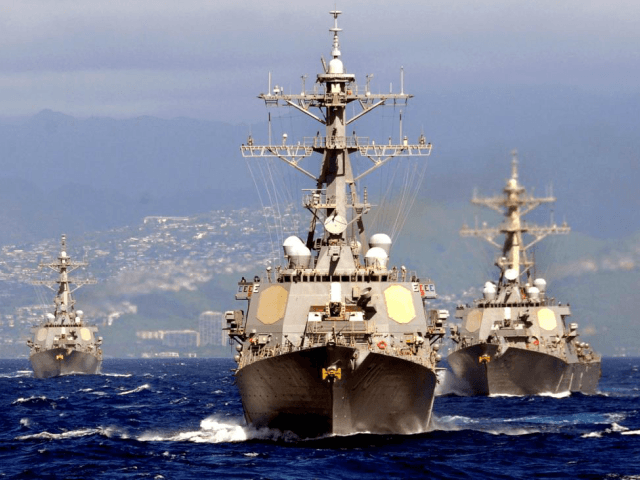The Chinese Foreign Ministry’s regular briefing Wednesday featured yet another tirade against the presence of U.S. military assets in the South China Sea, which have increased operations to keep the region free of Chinese colonization in the past year.
The Pentagon is reportedly considering expanding its Freedom of Navigation Operations (FONOPs) and recently flew B-52 bombers near the Spratly Islands, territory legally belonging to the Philippines and Vietnam that Beijing has reappropriated for its military use, contrary to international law.
“Several days ago, the U.S. Defense Secretary was accusing China of the so-called ‘militarization,'” Foreign Ministry spokeswoman Hua Chunying told reporters Wednesday. “Now, the U.S. military confirmed that it has flown B-52 bombers to the relevant airspace above the South China Sea. I wonder how the U.S. media would like to view these developments.”
“I would like to seek some clarification from the U.S. side. Is it an act of ‘militarization’ to fly offensive strategic weapons like the B-52 bombers to the South China Sea?! [punctuation in official foreign ministry transcript] Were the B-52 bombers there to safeguard navigation and overflight freedom?!” Hua asked.
“If someone armed to teeth comes to your doorstep every now and then, poking around and showing off muscles, aren’t you justified in sharpening vigilance, taking precautions, and increasing defense capacities?” she continued.
Hua concluded by “advising” the Pentagon to “stop stirring up troubles in the South China Sea, because freedom run amuck carries risks” and asserting China “will never be intimidated by some military vessels or planes.”
It is the second day that Hua issues such a stern condemnation of the United States’ presence in the region. On Tuesday, Hua told reporters, “China won’t be scared by any so-called military ship or aircraft, and we will only even more staunchly [take] all necessary steps to defend the country’s sovereignty and security. … Running amok is risky.”
China has also deployed its government-run media to condemn the United States for acting against the illegal colonization of territory in the region.
“The use of an offensive strategic weapon for the sole purpose of trying to strike fear into Beijing calls into question the U.S.’s claim that China is using its military power for ‘intimidation and coercion’ in the South China Sea,” the People’s Daily, the official newspaper of the Communist Party of China, argued in a piece published Thursday. “[I]f the goal of the flyover was to weaken China’s resolve to protect its territory, it failed miserably.”
“Like a Chinese saying goes, jackals and wolves will be met with force, but a friend will be welcomed with wine,” the People’s Daily concluded.
China claims territory in the South China Sea belonging to the Philippines, Vietnam, Brunei, Taiwan, and Malaysia. The Permanent Court of Arbitration at the Hague dismissed China’s claims in 2016 and concluded that its construction of artificial islands, armed with a variety of military weaponry, was illegal. China responded by vowing to disregard the ruling entirely and has continued to equip territory colonized in the Spratly and Paracel Islands – Philippine and Vietnamese territory – with military and surveillance assets.
The Pentagon’s assertive new policies appear to have taken some effect, however, according to a report from ImageSat International (ISI), an Israeli intelligence firm. ISI found that several missile systems China placed in the region are no longer visible on the islands they had been deployed to. Researchers were quick to caveat their findings, however – Chinese military officials could have pulled the missile systems for routine maintenance or simply hidden them in buildings. The timing of the move, shortly after the Pentagon reportedly mulled a new wave of FONOPs intended to keep China from unilaterally annexing the maritime territory, does suggest that Beijing has elevated its concern regarding America’s resolve in the region.
In addition to the B-52 flights and reports for more FONOPs, the Pentagon recently renamed its Pacific Command to “Indo-Pacific Command,” highlighting the South China Sea, which connects the two oceans.
“Having grown up in Washington state, one of five with a Pacific Ocean coastline, and looking out over the vast expanse of ocean during yesterday’s flight, I was reminded that the United States is today and has been for two centuries a Pacific nation,” Pentagon chief Jim Mattis said during a ceremony to commemorate the change. “America’s national defense strategy, a roadmap for America’s military, acknowledges this reality, taking a clear-eyed look at the world as it is, not how we would wish it to be.”
Other claimants in the region have also increased their military presence in the waters. The Taiwanese government held a major military drill before the visiting king of eSwatini (formerly Swaziland) Mswati III where Taiwanese soldiers fought against a simulated invasion, according to Reuters.
“Our armed forces’ combat effectiveness is the guarantee of our national security. It is the flourishing basis of society, and it is the back-up force for our values of democracy and freedom,” President Tsai Ing-wen said during the drills, which reports suggest are a response to growing belligerence against the island in Beijing.
In Malaysia, Kuala Lumpur is also considering further military preparation in fears of a growing Chinese threat. Defense Minister Mohamad Sabu told reporters Thursday that the new government of Prime Minister Mahathir bin Mohamad would work to strengthen the Royal Malaysian Navy, “especially with the increasingly tense territorial disputes in the South China Sea,” the Malaysia Star reported.
“He said Malaysia has to be ready, not for war, but to protect its sovereignty,” the newspaper noted, quoting Sabu as telling reporters, “we don’t want the Middle East conflict between the bigger powers to be brought here.”
Follow Frances Martel on Facebook and Twitter.

COMMENTS
Please let us know if you're having issues with commenting.